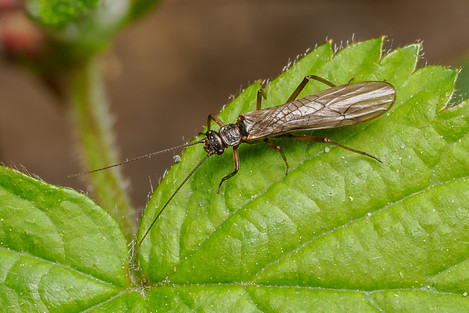Small World Discoveries
by Tony Enticknap - tickspics
Focusing on insects, arachnids and other small nature subjects from East Dorset and the New Forest ...
PLECOPTERA | Stoneflies
Stoneflies are slender, somewhat flattened, soft-bodied insects with noticeable bulbous eyes and long thread-like antennae. They are mainly small with many only having a body length of a few millimetres, although some of the larger species may average around 20mm. They are typically brown or yellowish in colour with long membranous wings that are generally held tight to the abdomen when the insect is at rest. The wings though are only good for short flights, so unless they've been carried on the wind like the individual I discovered in our garden, they will be found near running water where the nymphs live. The adults are mainly nocturnal and generally short-lived.
Some 34 species occur in Britain, separated into seven distinct families that can be put into two groups; those with short 'tails' (cerci) that do not protrude beyond the end of the forewings, and those with long 'tails' that extend well beyond.
The three short 'tailed' families are Leuctridae, Nemouridae and Taeniopterygidae.
Leuctridae (6), known as 'needle flies' from the way they wrap their wings around their body in a tubular shape. Some emerge as early as February, whilst others are still flying into late autumn. Identification to genus is as good as it gets without microscopic examination.
Nemouridae (11), 'small brown stoneflies', mostly widespread and common but, in most cases, require detailed examination to distinguish.
Taeniopterygidae (4), most emerge early in the year, peaking in March, and known by anglers as 'February reds'. They are small and dark, and have at least one darker band on the forewing. The four species can be separated by slight differences in forewing venation and antenna structure.
The four long 'tailed' families are Capniidae, Chloroperlidae, Perlidae and Perlodidae.
Capniidae (3), 'black stoneflies', small and dark, emerge in the spring. One, Zwicknia bifrons, is relatively common, the other two mainly found in Scotland.
Chloroperlidae (3), the anglers 'small yellow sallies', two are widespread and common.
Perlidae (2), 'large stoneflies' that are far more common in northern Britain.
Perlodidae (5), two groups, the larger 'Perlodid stoneflies' (3) and the smaller 'yellow sallies' (2), all with a yellow or orange line on the head and thorax. Probably the most common larger species is the Orange-striped Stonefly [Perlodes mortoni] and the smaller, the Common Yellow Sally [Isoperla grammatica].
The individuals featured below were all kindly identified by Craig Macadam of the 'Stonefly Recording Scheme'.
In respect of the one that appeared in our garden, identification started with the segments of the foot all being roughly the same length, whereas in Leuctridae the first and third segments are similar, but the second is tiny; and then by the barely marked wings, which confirmed Taeniopteryx nebulosa, as the other Taeniopterygidae all have distinctive dark bands. It has two distinct habitats; slow moving lowland rivers such as the Dorset Stour and fast-flowing upland rivers, but in both they live in the pools and slacks. They are never recorded from still water, which is why this individual must have been carried some distance on the wind.
The small individual I found at Slop Bog is a widespread and frequently observed species and, although identification normally requires detailed examination, there were sufficient features visible in the photos to determine that it was almost certainly Nemoura cinera, commonly known as the Small Dull Brown.
Although I was pretty sure that the individual I managed to photograph at Moors Valley was a Leuctra 'needle fly', I wanted to see if it could be properly identified. It couldn't, but I did find out that the six species in this family could be divided into two groups: the early winter/spring species, being L.hippopus, L.inermis and L.nigra; and the later summer/autumn species, L.fusca, L.geniculata and L.moselyi. The time of year determined that it was one from the latter group, from which L.geniculata could have been identified by having a whorl of hairs at each joint of the antennae except that that feature couldn't be seen, which narrowed it down to one of the other two species.

Taeniopteryx nebulosa
Three Legged Cross (garden), East Dorset | Feb.21

Taeniopteryx nebulosa
Three Legged Cross (garden), East Dorset | Feb.21

Leuctra 'needle fly' sp. - Leuctra fusca or moselyi
Crane Lake, Moors Valley CP, East Dorset | Sept.22

Taeniopteryx nebulosa
Three Legged Cross (garden), East Dorset | Feb.21

Nemoura cinerea
Slop Bog, Ferndown, East Dorset | May 22

Leuctra 'needle fly' sp. - Leuctra fusca or moselyi
Crane Lake, Moors Valley CP, East Dorset | Sept.22
Original list created Dec.22 | updated - (v.1)